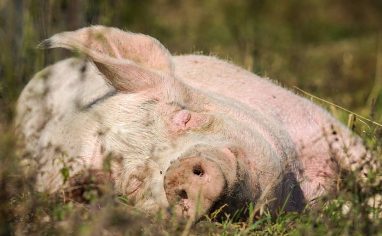
Updated September 25, 2020
It can be a challenge to ensure alpaca residents have healthy, happy lives after coming to a sanctuary, and there are many different aspects of care to consider each day. Unfortunately, toxic and poisonous hazards are sometimes overlooked in the hustle and bustle of operating a sanctuary. While minor exposure to many of these toxins are unlikely to cause serious problems, large amounts can cause severe health issues and sadly, even death. There are also some toxins that are highly dangerous even in small amounts.
In order to help ensure you never run into this problem, we have compiled this resource of common plants and other potentially toxic things that have been known to be a problem for alpacas.
While prevention is imperative when it comes to protecting your residents from toxins, in the event that they accidentally ingest something toxic, the administration of an activated charcoal product may help absorb the toxins. This is not a magic cure and may not be appropriate in all situations, but it can be helpful to have on hand. We suggest asking your veterinarian if there are specific products they recommend for the various species in your care so you can have them ready should you need them. In addition to seeking urgent medical care, if a resident ingests a toxin, ask your veterinarian if administration of activated charcoal is advised.
Plants That Are Toxic To Alpacas
Please see The Open Sanctuary Project’s Global Toxic Plant Database and filter Species Afflicted by alpacas in order to see a list of plants across the world that are toxic to alpacas. Please note that, while comprehensive, this list may not contain every single plant toxic to alpacas!
Other Potential Alpaca Toxins
Algae
Blue-green algae, which is most often found in stagnant, slow-moving water when temperatures are high, can poison alpacas. Symptoms generally develop quite rapidly and may resemble an allergic reaction. Convulsions may occur, but more frequently the animal sinks to the ground, and dies without struggling. Smaller amounts of poison cause weakness and staggering, followed by recovery. In some instances, apparent recovery from an attack is followed in a few days or weeks by evidence of photosensitization. There may be inflammation of the muzzle, the skin of the ear, the udder, or other parts of the body. Jaundice is often seen, and constipation is a common symptom. Such cases usually recover under good care.
Cantharidiasis (Blister Beetle Poisoning)
Blister beetles contain cantharidin, a toxic substance that is used as a defense mechanism against predators. There are more than 200 different species, and they can be found from Mexico to Southern Canada, and from the east coast of the United States as far west as New Mexico. Cantharidin can severely injure or kill alpacas when even a small amount is ingested. Alpacas come into contact with cantharidin by ingesting alfalfa hay that has been infested by blister beetles. The oily substance can contaminate the hay even if the beetles were crushed into the feedstuff. Crushing or chemically eradicating the beetles does not diminish the toxin potency.
Inspecting individual flakes of alfalfa hay before providing them to residents can help reduce the likelihood of poisoning. Dispose of any contaminated flakes, even if you have removed the beetle, as the toxin can still be left behind. First-cutting hay is less likely to be contaminated than hay harvested later in the year, as the insects likely haven’t yet swarmed by then. Harvest alfalfa before it fully blooms to reduce the chances of beetle contamination. Hay is less likely to be contaminated by crushed beetles when harvested with a self-propelled mower or windrower. Crimping hay crushes the beetles into the hay.
Alpacas that ingest a massive amount of toxin may show signs of severe shock, and unfortunately, die within hours. Symptoms of sublethal poisoning include depression, diarrhea, elevated temperatures, increased pulse and breathing rates, and dehydration. There is also frequent urination, especially after the first 24 hours. If cantharidin poisoning is suspected, a veterinarian should be contacted immediately.
If you suspect Blister Beetle Poisoning, contact your veterinarian immediately. If early veterinary care is provided, afflicted alpacas have a chance of recovery.
Copper
Like sheep, alpacas (and llamas) are more likely to suffer from copper toxicity. Because of this, they should not have access to mineral salt blocks or loose mineral mixes unless they contain no copper, such as those formulated for sheep. Copper toxicity is a result of too much copper in the diet. Typically due to ingestion of something not intended for alpacas such as chicken feed, cow mineral, or pig mineral. A sign of copper toxicity is copper colored urine. The urine will also have a sweet smell.
Grain Overload (Acidosis, Grain Poisoning)
Grain overload occurs when alpacas eat large amounts of grain, causing an increase in lactic acid production. Lactic acid is produced resulting in slowing of the gut, dehydration, and sometimes, sadly, death.
Grain overload is most commonly seen when alpacas gain access to bags or cans of grains and pellets. If an alpaca isn’t accustomed to eating grain, a sudden switch to grains might cause grain overload as well. In general, alpacas require very little grain in their diet. While ruminants may start showing symptoms fairly early on, alpacas and llamas are less likely to exhibit symptoms until it is too late. For this reason, if you suspect grain overload, call a vet immediately!
Signs of grain overload include:
- depressed appearance
- lying down
- diarrhea
- dehydration and thirst
- bloating (of the left side of the abdomen)
- staggery or tender gait and ‘sawhorse’ stance
- death
Sweet feed should not be fed to camelids, as the high amounts of sugar and starch can cause digestive upsets such as bloat. Only feed grains designed for camelids and use these in moderation.
Lead Toxicity
Lead was once used in paints and pesticides, and can also be found from natural environmental sources. Even if you have never used any products containing lead, it may still be present in old barn or fence paint, or in the soil. Places where old machinery and leaded gas have been stored may also have caused contamination, as would old treated lumber and railroad ties. Alpacas may ingest the lead in the environment through the consumption of grass, clover, and dandelion or from chewing or licking on tainted surfaces.
Having the soil tested at your sanctuary is an easy way to learn if the environment is safe for residents. You can check with a local environmental conservation service, or agricultural extension office to inquire about testing. It is usually a fairly quick and easy process. Prevent your residents from accessing buildings and fences with old paint, as they may chew or lick these objects and ingest lead.
Alpacas with low levels of lead toxicity do not generally exhibit signs. In severe cases, you may see the following symptoms:
- loss of appetite
- weight loss
- lethargy and weakness
- incoordination
- anemia
- unusual manure consistency or diarrhea
- respiratory distress or blindness
Consult a veterinarian immediately if you suspect an alpaca has ingested lead or is beginning to show symptoms of lead poisoning.
Mycotoxins
Mycotoxins are a toxin produced by molds (fungi) that are harmful to many animals. Mycotoxins can affect alpacas through contaminated food or bedding. Moist, warm environments make a perfect recipe for mold reproduction. The type and amount of mycotoxin an alpaca ingests affects whether the health issues are immediate and short-lived or may become chronic issues. Pregnant alpacas and young alpacas are more susceptible. Some general signs of poisoning include:
- appetite loss
- weight loss
- respiratory issues
- increased susceptibility to infectious diseases (poor immune function)
- poor growth rate
Prevention is key in avoiding serious health issues. Luckily, there are a number of steps you can take to help ensure resident alpacas do not suffer the ill effects of mycotoxin poisoning:
- Be sure to keep food, grain, and hay storage areas clean, dry, and cool
- Try to keep food storage areas protected from mice and rats and other wildlife, as they can chew holes in food bags, increasing the likelihood of grain being exposed to damp conditions
- Always feed the oldest sources of food first. Try to use up open food bags within a few weeks after opening in the winter and in even less time in the summer
- Clean any storage bins or cans thoroughly to remove old grain that may get stuck in cracks and crevices
- Check with your food manufacturer or supplier to see if they regularly test for the presence of mycotoxins in grains before mixing food. If they do not, avoid using them and find another supplier
If you are concerned about the possibility of mycotoxin contamination, have your food stores tested. This could be especially important if you have an alpaca that shows initial signs of mycotoxin exposure.
Pesticides, Herbicides, And Rodenticides
It may not come as a surprise that herbicides and rodenticides can cause toxicosis in alpacas if ingested. If alpacas ingest plants that have been sprayed with phenoxy acid herbicides, they can become ill or even die. For this reason, it is imperative that alpacas are not given treated plants or are allowed access to pastures that have been treated with herbicides.
While rats and mice can pose challenges for sanctuaries, it is important to respect them and use compassionate mitigation practices. Many rodenticides are anticoagulants and act by preventing the blood to clot. These products may be appealing to alpacas as well, and they may attempt to lick or eat them if discovered. For this reason, it is imperative that they do not come into contact with these poisons. There are many new and innovative ways to address rodent populations that are more effective and compassionate.
Pesticides may affect the nervous system in alpacas and can be fatal if not treated with the antidote. Early treatment is critical. If you suspect an alpaca may have ingested any of the poisons above, contact your veterinarian immediately. Blood tests may confirm poisoning.
Selenium
Selenium is a highly toxic element when taken in quantities larger than what is needed for normal metabolism. In most plants, the level of selenium is related to levels in the soil. The symptoms of selenium poisoning are: dullness, stiffness of joints, lameness, loss of hair from their body or tail, and hoof deformities. The acute form of poisoning is often called “blind staggers”.
Snakebites
Venomous snakebites are not common, but when they occur, should be treated seriously and immediately. The most common location for an alpaca to be bitten are on the nose or leg. It is possible for a snake to bite several times, so if you notice a snakebite, look for others. Snake venom varies by species, and the severity of a bite can also be influenced by size, age, and the number of bites. Most venoms can impair blood clotting and damage the heart, while some others contain neurotoxins. Signs of a snakebite may include:
- pain
- swelling at the bite site
- one or more puncture wounds
- sloughing of tissues near the bite site
- cardiac arrhythmias
- impaired ability for their blood to clot
- shock
- collapse
- paralysis
- death
Seek veterinary care immediately if an alpaca is bitten by a venomous snake. Do NOT try to suck the venom out or place a tourniquet. Keep the alpaca calm while seeking immediate veterinary care. Depending on the severity of the bite, treatments may include antivenin, pain medications, fluid therapy, wound treatment, tetanus vaccination, and antibiotics. Check out our Compassionate Wildlife Practices At Your Animal Sanctuary for some tips on how to dissuade snakes from your property.
Wood Stains And Paints
Some wood stains and paints can be toxic to alpaca. Alpacas may try to chew on painted surfaces and can become ill if the stain or paint is toxic. Try and purchase paints and stains that are specially made for barns and fencing and listed as animal or “livestock” friendly.
Foods That Can Be Toxic To Alpacas
Consider These Variables
You may see food on this list that you have fed to your residents without any apparent issue. That may be because some foods are toxic in higher amounts while others are toxic in small amounts or whether they are being consistently offered the food over a period of time. It can also depend on the individual. We all have sensitivities to different things. Just as there are dogs who have eaten chocolate and don’t show clinical or subclinical signs of poisoning, there are many dogs that weren’t so lucky. The amount that may cause one resident to become ill (or even die) may be different for another resident. Different breeds or species can also affect their sensitivity to a toxin. In addition to these considerations, certain plants, fruits, vegetables, and other foods listed below may contain varying amounts of the toxin. The toxicity in some fruits and vegetables may even depend on their ripeness, the amount of sun exposure, the temperature, and more! Below we have put together a list of foods that are known to contain some toxin that is potentially harmful to alpacas. It is our hope that providing this information will help you provide the best care possible to your residents. When possible, we have researched scientific papers to provide solid sources and tried to give more details. However, it is not an exhaustive list and is not meant to replace veterinary advice.
If You Have The Slightest Doubt…
Just because something might not be listed here as a toxic food or substance for alpacas, please do not take that to mean it’s safe to give them! Even normally non-toxic produce can cause health issues if given in large amounts. Check our Daily Diet, Supplement, & Treats For Alpacas resource and see if it’s listed as a safe treat for alpacas residents. If you aren’t positive that it will be safe for alpacas, it’s best to avoid feeding it to them in order to be as safe as possible!
In addition to the above, here are some foods that can be toxic to alpacas:
- Animal products of any kind
- Avocado
- Cherries
- Chocolate
- Kale
- Nightshade vegetables
- Potato
While this list isn’t exhaustive, it can certainly help you keep resident alpacas safe, healthy, and happy!
SOURCES:
Is There Lead In Your Pasture? | Of Horse
Animal Friendly Barn And Fence Paint For Horse Stalls | Stuff For Petz
Copper Nutrition In Camelids | Penn State Extension (Non-Compassionate Source)
Blister Beetles | North Carolina State University Extension Service (Non-Compassionate Source)
The Danger Of Mycotoxins | The Horse (Non-Compassionate Source)
Grain Overload, Acidosis, Or Grain Poisoning In Stock | Department Of Primary Industries And Regional Development’s Agriculture And Food (Non-Compassionate Source)
Toxin Topic: Snakebites And Horses | The Horse (Non-Compassionate Source)
Plant Poisoning Of Llamas And Alpacas | Vermont Llama and Alpaca Association
Poisoning of LivestockAnother term for farmed animals; different regions of the world specify different species of farmed animals as “livestock”. by Plants | Ontario Ministry Of Agriculture, Food And Rural Affairs (Non-Compassionate Source)
Common Weeds Poisonous to Grazing Livestock | Ontario Ministry Of Agriculture, Food And Rural Affairs (Non-Compassionate Source)
Protect You Horses And Livestock From Toxic Plants | Washington State Department Of Agriculture (Non-Compassionate Source)
South American Camelid Information (Alpacas and Llamas) | Large Animal Practice (Non-Compassionate Source)
If a source includes the (Non-Compassionate Source) tag, it means that we do not endorse that particular source’s views about animals, even if some of their insights are valuable from a care perspective. See a more detailed explanation here.








